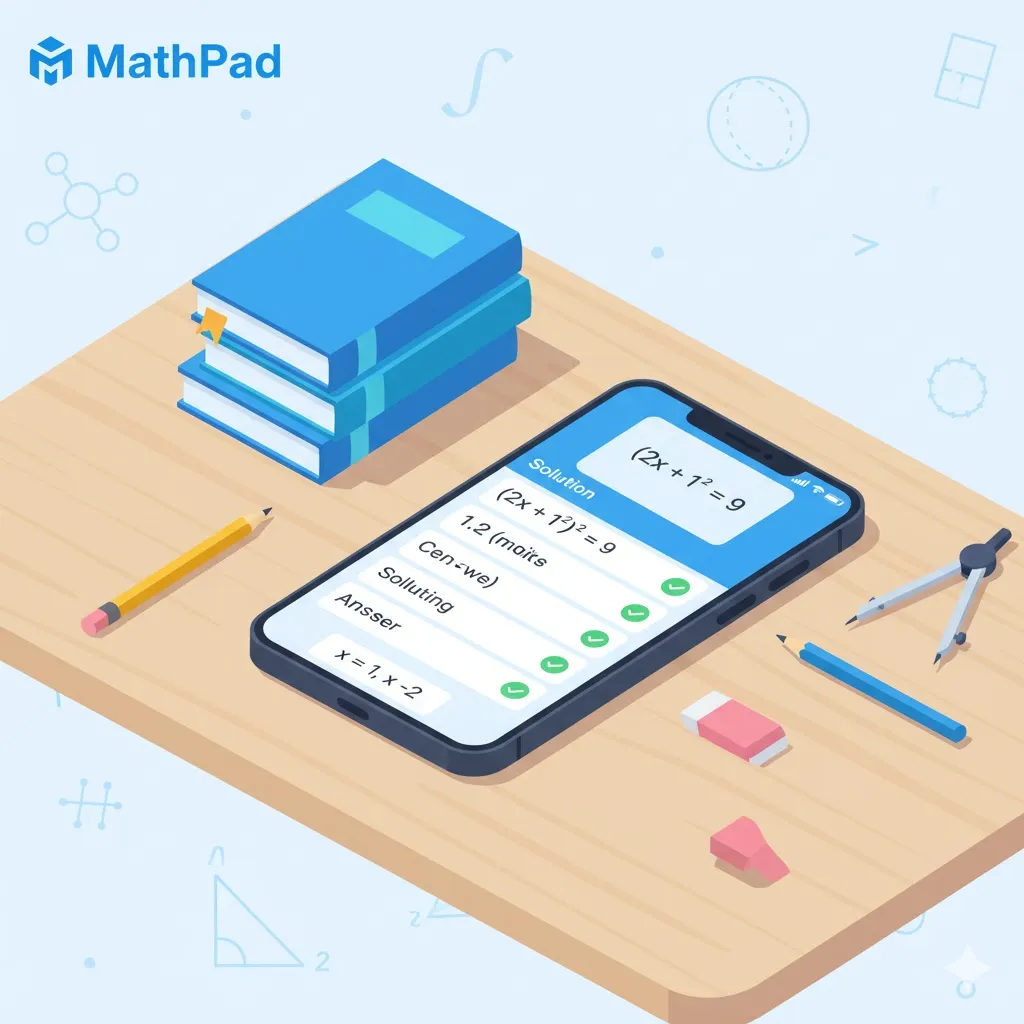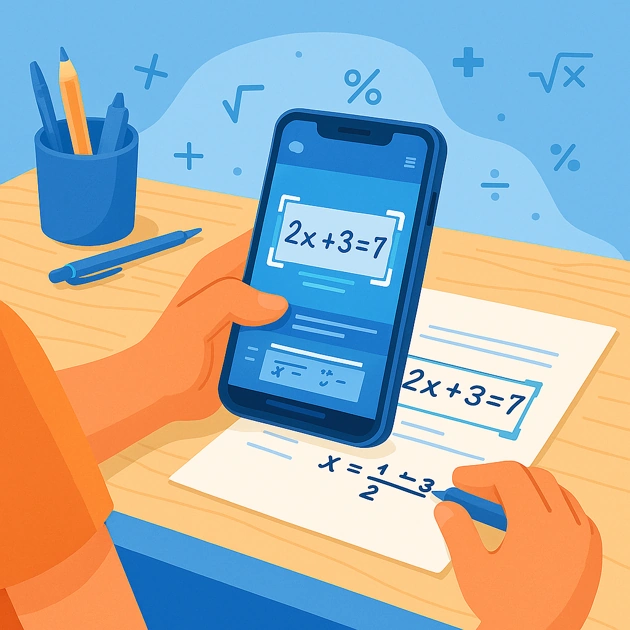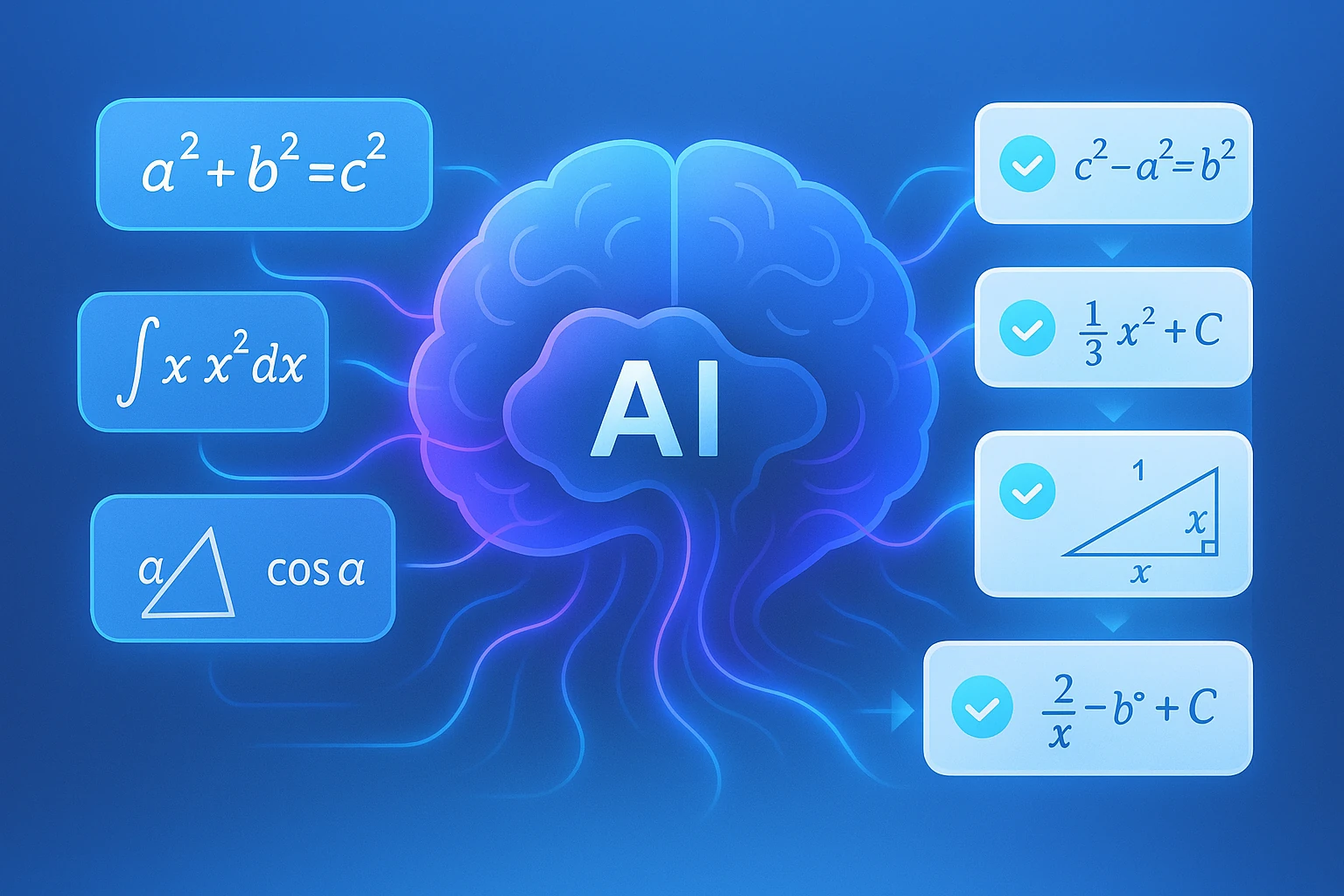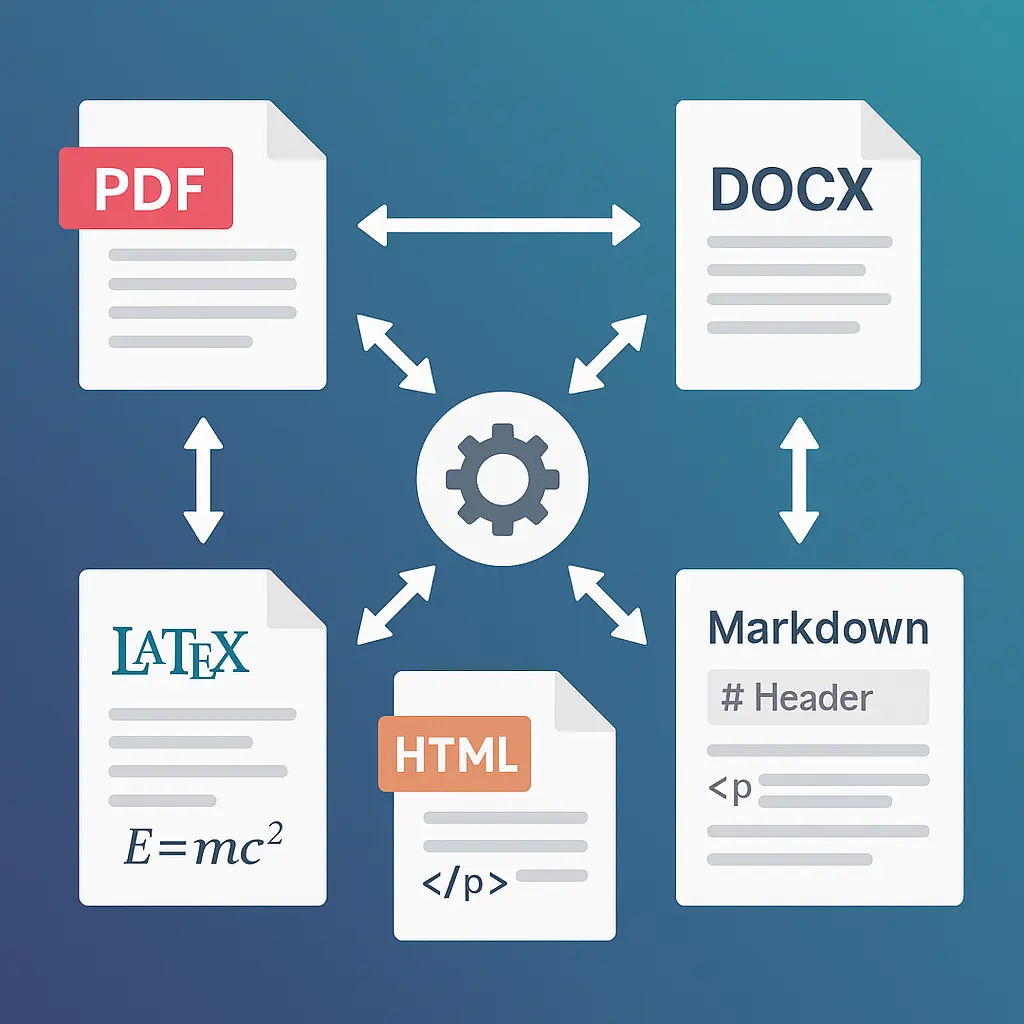Point your phone's camera at a math problem, tap a button, and get an instant solution with step-by-step explanations. Sounds too good to be true? It's not—photo math technology has come a long way, and it's changing how students learn.
But here's what most people don't know: not all photo math apps are created equal. Some give you answers without explanations (useless for learning). Others struggle with handwriting or specific problem types. This guide will show you what actually works.
💡 Pro tip: The secret to getting accurate results from photo math isn't just the app you choose—it's how you photograph the problem. Good lighting, proper angle, and clear handwriting make all the difference.
📸 Ready to get unstuck? Try MathPad Free →
Looking for a detailed comparison? Check out our guide to the Best Photomath Alternatives.
How Photo Math Calculators Work
When you snap a photo of a math problem, here's what happens in those 2-3 seconds:
Step 1: Image Capture and Preprocessing
Your phone camera captures the image, then the app processes it:
- Crops and straightens the image to isolate the problem
- Adjusts contrast to make text clearer
- Removes background noise (shadows, wrinkles in paper, etc.)
- Deskews angled photos to make text more readable
This preprocessing is crucial—it's why a well-lit, straight-on photo works better than a dim, angled one.
Step 2: Optical Character Recognition (OCR)
This is where the magic happens. The app uses OCR trained specifically on mathematical notation:
- Machine learning models trained on millions of math problems
- Recognizes handwriting (even messy handwriting, though clearer is better)
- Identifies mathematical symbols: $\int$, $\sum$, $\pm$, $\frac{a}{b}$, etc.
- Understands structure: fractions, exponents, matrices, equations
Modern OCR for math goes way beyond simple text recognition. It understands that $x^2$ is different from $x_2$, that $\frac{a}{b}$ is a fraction, and that $\int_0^1 f(x)dx$ is an integral with specific bounds.
Step 3: LaTeX Conversion
The app converts the recognized math into LaTeX—the standard format for mathematical typesetting:
- Handwritten: "$x$ squared minus five $x$ plus six equals zero"
- OCR recognizes: image pixels → mathematical structure
- Converts to LaTeX:
x^2 - 5x + 6 = 0
This conversion is critical because LaTeX is what computer algebra systems understand.
Step 4: Problem Classification
The AI analyzes what type of problem it is:
- Algebra (linear, quadratic, polynomial)?
- Calculus (derivative, integral, limit)?
- Trigonometry (identities, equations)?
- Statistics (probability, distributions)?
- Geometry (area, volume, proofs)?
This classification determines which mathematical engine to use.
Step 5: Solution Generation
Finally, the app solves the problem:
- Computer Algebra System (CAS) performs symbolic manipulation
- Step-by-step breakdown shows the logical progression
- Natural language explanations describe what's happening in each step
The best apps don't just give you an answer—they teach you the method so you can solve similar problems yourself.
Accuracy and Limitations
Modern photo math apps are impressively accurate, but they're not perfect:
High accuracy (95%+) for:
- Printed textbook problems
- Clear handwriting with standard notation
- Well-lit, straight-on photos
- Common problem types (algebra, calculus, trig)
Lower accuracy or failures with:
- Very messy or cursive handwriting
- Unusual mathematical notation
- Poor lighting or blurry photos
- Diagrams mixed with text
- Word problems requiring contextual understanding
Knowing these limitations helps you get better results.
Top Photo Math Calculator Alternatives Compared
Let's look at the leading photo math calculators, their strengths, and their weaknesses. This is an honest comparison—no fluff.
MathPad SnapSolve
Best for: Students who want to actually learn, not just get answers
Key features:
- Photo recognition for handwritten and printed problems
- Step-by-step solutions with detailed explanations
- Integrated AI Tutor for follow-up questions
- Step Checker to verify your own work
- Practice problem generator
- Works with algebra, calculus, trigonometry, statistics, linear algebra
Accuracy: Handles most handwriting styles well; struggles occasionally with very cursive writing
Price: Free tier with limited daily problems; premium from $14.99/month
What sets it apart: The AI Tutor integration. After seeing a solution, you can ask "why did you use that method?" or "is there another way to solve this?" and get contextual explanations. The Step Checker also lets you photograph your own solution to see where you went wrong.
Photomath
Best for: Quick answers with clear step-by-step breakdowns
Key features:
- Excellent OCR for both print and handwriting
- Animated solution steps
- Covers elementary math through calculus
- Multiple solution methods shown
Accuracy: Very high for standard problems; excellent print recognition
Price: Free basic version; Photomath Plus ~$10/month
Limitations: Less interactive than MathPad; can't ask follow-up questions; weaker on advanced topics like differential equations or linear algebra
Microsoft Math Solver
Best for: Integration with OneNote and Microsoft ecosystem
Key features:
- Photo recognition and keyboard input
- Step-by-step solutions
- Video lessons linked to similar problems
- Practice problems
Accuracy: Good for basic to intermediate problems
Price: Completely free
Limitations: Less polished OCR than specialized apps; fewer advanced features; doesn't handle complex handwriting as well
Socratic by Google
Best for: Broad subject coverage (not just math)
Key features:
- Photo recognition for math, science, history, English
- Pulls explanations from across the web
- Links to Khan Academy and other educational resources
- Completely free
Accuracy: Good for common problems; can struggle with unusual notation
Price: Free
Limitations: Solutions are less detailed than specialized math apps; sometimes links to resources instead of solving directly; better for concepts than complex calculations
Comparison Table
| Feature | MathPad | Photomath | Microsoft Math | Socratic |
|---|---|---|---|---|
| Math-Specific OCR | ✓ Yes | Partial | No | No |
| OCR Quality | Excellent | Excellent | Good | Good |
| Handwriting | Very Good | Very Good | Fair | Fair |
| CAS-Verified Solutions | ✓ Yes | No | No | No |
| Step-by-Step | Yes | Yes | Yes | Sometimes |
| Interactive AI Tutor | ✓ Yes | No | No | No |
| Advanced Math | Calc I-III, Linear Algebra, Diff Eq | Basic Calc | Basic Calc | Limited |
| Practice Problems | Unlimited | Limited | Yes | No |
| Price | Free + $14.99/mo | Free + ~$10/mo | Free | Free |
| Best For | Serious Learning | Quick Answers | Microsoft Users | Multiple Subjects |
What sets MathPad apart: Math-specific OCR (not generic text recognition), CAS-verified solutions that prevent AI hallucinations, and interactive AI Tutor for follow-up questions.
💡 Pro tip: Use the free versions of 2-3 apps to see which interface you prefer. The best app is the one you'll actually use consistently.
Best Practices for Photo Math
Want accurate results every time? Follow these guidelines:
Lighting
Do:
- Use natural daylight or bright indoor lighting
- Make sure the problem is evenly lit (no shadows across the equation)
- Avoid glare on glossy paper
Don't:
- Photograph in dim lighting
- Use flash that creates hot spots or glare
- Backlight the paper (light source behind it)
Pro tip: If you're getting glare, tilt the paper slightly so light bounces away from the camera.
Angle and Distance
Do:
- Hold your phone directly above the problem (straight-on view)
- Fill most of the frame with the math problem
- Keep the camera steady (use both hands or prop your elbows)
Don't:
- Take photos at sharp angles (perspective distortion confuses OCR)
- Include too much surrounding content
- Crop too tightly—leave a little margin
Ideal distance: 6-12 inches above the paper for most phone cameras.
Handwriting Clarity
Do:
- Write clearly with good spacing between lines
- Use distinct notation ($x$ vs $\times$, $\cdot$ for multiplication)
- Make fractions clear with horizontal bars
- Use proper mathematical symbols
Don't:
- Write too small or too large
- Cramp multiple problems together
- Mix cursive with print
- Cross out work without erasing—it confuses the OCR
Pro tip: If your handwriting is consistently problematic, try rewriting the problem neatly on a clean sheet specifically for photographing.
When to Type Instead
Sometimes typing is better than photographing:
- Very long expressions (easier to type than photograph)
- Multi-line proofs (photos can misread logical flow)
- Problems with diagrams (OCR struggles with graphics mixed with text)
- After multiple photo failures (if the app can't read it after 2-3 attempts, typing is faster)
Most photo math apps also have keyboard input for these situations.
For detailed mobile-specific tips and on-the-go use cases, see our complete Math Solver with Camera guide →.
What Problems Can Photo Math Solve?
Let's be realistic about capabilities and limitations:
Algebra (Excellent)
Works well:
- Linear equations: $2x + 5 = 13$
- Quadratic equations: $x^2 - 5x + 6 = 0$
- Systems of equations
- Polynomial factoring and expansion
- Rational expressions
- Absolute value equations
- Inequalities
Example: $3x^2 - 12x + 9 = 0$
The app will:
- Identify $a=3$, $b=-12$, $c=9$
- Calculate discriminant: $(-12)^2 - 4(3)(9) = 36$
- Apply quadratic formula
- Show solutions: $x = 3$ or $x = 1$
Calculus (Very Good)
Works well:
- Derivatives (all basic rules)
- Integrals (standard techniques)
- Limits
- Related rates (simple problems)
- Optimization (with clear objective functions)
Example: $\frac{d}{dx}(x^2 \sin(x))$
The app will:
- Identify this as a product of two functions
- Apply product rule: $f'g + fg'$
- Show: $2x\sin(x) + x^2\cos(x)$
Limitations:
- Complex word problems requiring extensive setup
- Multi-step optimization with constraints
- Differential equations beyond basic separable types
- Proofs (apps solve, they don't prove theorems)
Trigonometry (Very Good)
Works well:
- Solving trig equations
- Simplifying trig expressions
- Verifying identities (shows steps)
- Triangle solving (given sides/angles)
Example: Solve $2\sin(x) = 1$ for $0 \leq x \leq 2\pi$
The app will:
- Isolate: $\sin(x) = \frac{1}{2}$
- Identify reference angle: $\frac{\pi}{6}$
- Find all solutions in range: $x = \frac{\pi}{6}$ or $x = \frac{5\pi}{6}$
Statistics (Good)
Works well:
- Basic probability calculations
- Mean, median, mode, standard deviation
- Simple regression
- Probability distributions (basic)
Limitations:
- Hypothesis testing (requires interpretation)
- Complex statistical inference
- Data analysis requiring context
Geometry (Fair to Good)
Works well with:
- Area and perimeter formulas
- Volume and surface area
- Coordinate geometry (distance, midpoint, slope)
Struggles with:
- Diagram interpretation (OCR can't "see" angles or lengths marked on diagrams)
- Proofs (requires logical reasoning, not just calculation)
- Construction problems
Workaround: For geometry with diagrams, you often need to type the given information rather than photograph.
What Photo Math Can't Do
Be realistic about limitations:
- Word problems requiring setup: The app can solve equations, but might not correctly interpret "John has 3 more apples than Sarah..."
- Proofs: Mathematical proofs require logical reasoning that apps don't provide
- Show all work for credit: Teachers often want to see your process, not an app's
- Understand context: "Is this answer reasonable?" requires human judgment
Using Photo Math as a Learning Tool
Here's how to use photo math apps to actually learn, not just cheat:
📸 Ready to get unstuck? Try MathPad Free →
The Right Way to Use Photo Math
1. Try the problem yourself first
- Spend at least 5-10 minutes attempting it
- Write down what you know and what you're trying to find
- Identify which method you think applies
2. Use the app if you're stuck
- Photo the problem to see the solution
- Don't just copy the answer—study each step
- Ask yourself: "What did they do here? Why did they do that?"
3. Try a similar problem without help
- Use the app's practice problem generator or find a similar textbook problem
- Solve it entirely on your own
- Then check your answer with the app
4. Use the app to verify your homework
- Complete your homework independently
- Photo each problem to check answers
- If you got one wrong, study the correct solution to understand your mistake
The Wrong Way to Use Photo Math
Don't:
- Photo every problem without trying them first
- Copy answers without understanding the steps
- Submit photo app solutions as your own work (academic integrity violation)
- Rely on it during timed tests (you won't have it in exams)
Study Techniques with Photo Math
Mistake Pattern Analysis:
- Photo 10 similar problems you solved
- Identify which ones you got wrong
- Look for patterns: "I always forget the negative sign in derivatives" or "I mix up sin/cos derivatives"
- Focus practice on your specific weak areas
Speed Building:
- Time yourself solving a problem
- Check the solution with photo math
- Try similar problems, aiming to match the app's step logic
- This builds both speed and accuracy
Concept Mapping:
- When the app solves a problem, pause at each step
- Ask: "What concept is being used here?"
- Create a concept map linking methods to problem types
MathPad's SnapSolve: What Makes It Different
Full disclosure: we're obviously biased toward MathPad. But here's what genuinely sets SnapSolve apart:
Math-Specific OCR (Not Generic Text Recognition)
Unlike generic OCR that treats math like regular text, MathPad uses specialized mathematical OCR trained specifically on:
- Complex mathematical notation (integrals, summations, matrices)
- Handwritten math symbols that look similar ($x$ vs $\times$, $\cdot$ vs $.$)
- Structural relationships (fractions, exponents, subscripts)
- Multi-line equations and systems
This is why MathPad handles complex calculus and linear algebra problems that make other apps struggle.
AI + Computer Algebra System (CAS) = No Hallucinations
Here's the critical difference: Most AI math solvers guess at patterns and can make mistakes. MathPad combines AI with a Computer Algebra System (CAS) that verifies every step symbolically before showing it to you.
How it works:
- AI proposes a solution method
- CAS verifies each step mathematically (not pattern-matching)
- If any step is wrong, CAS catches it
- You only see verified, accurate solutions
This is why MathPad doesn't give you confident-sounding wrong answers like pure AI tools can. Every solution is mathematically verified. Learn more about our accuracy approach →
Integrated AI Tutor
After SnapSolve shows you a solution, you can ask questions:
- "Why did you use the quadratic formula instead of factoring?"
- "Can you solve this a different way?"
- "I don't understand step 3—can you explain it differently?"
The AI Tutor understands the context of the problem you just solved and gives tailored explanations.
Step Checker
This is unique: You photograph your own solution (your handwritten work), and MathPad checks each step:
- Identifies where your logic diverged from the correct method
- Highlights which step contains the error
- Explains what went wrong and how to fix it
This is way more valuable than just seeing a correct solution—it teaches you to debug your own thinking.
Practice Problem Generator
After solving one problem, click "Practice Similar" and get 5-10 problems of the same type with different numbers. This builds fluency faster than anything else.
Multi-Subject Coverage
SnapSolve handles:
- Algebra (all levels)
- Calculus (through multivariable)
- Linear algebra
- Differential equations
- Statistics
- Trigonometry
Most photo math apps focus on algebra and basic calculus; MathPad goes further.
Privacy and Ethics
Let's address the elephant in the room:
Is Using Photo Math Cheating?
It depends on how you use it:
Not cheating:
- Checking your completed homework before submitting
- Learning from solutions to understand concepts
- Practicing with generated problems
- Verifying answers on practice exams (when allowed)
Cheating:
- Using it during in-class quizzes or tests (unless explicitly allowed)
- Submitting app solutions as your own work
- Using it on take-home exams (unless explicitly allowed)
- Photoinging problems without attempting them yourself
The academic integrity line: If your teacher/professor says "show your work" or "no calculators," then photo math isn't allowed. If they say "use any resources," it's fair game. When in doubt, ask.
Data Privacy
When you photograph math problems, what happens to your data?
MathPad:
- Images are processed and not stored long-term
- No personally identifiable information collected from photos
- Solutions and interactions used to improve AI (anonymized)
- See our privacy policy for full details
Best practices:
- Don't photograph pages with your name/ID on them
- Check the app's privacy policy
- Understand what data is being collected
- Use school/parent-approved apps
Academic Honesty Guidelines
For students:
- Use photo math as a tutor, not a crutch
- Always try problems yourself first
- Never submit app solutions as your own work
- On assessments, only use tools explicitly allowed by your teacher
For teachers/parents:
- Photo math apps aren't going away—teach appropriate use
- Focus on assessing understanding, not just answers
- Consider in-class assessments where phones aren't available
- Use photo math apps yourself to understand what students have access to
Getting Started with Photo Math
Ready to try photo math? Here's your step-by-step guide:
Step 1: Choose Your App
Based on your needs:
- Want to truly learn? → MathPad (AI Tutor + Step Checker)
- Want quick answers? → Photomath or Microsoft Math
- Need multiple subjects? → Socratic
Download from App Store or Google Play, or use the web version (MathPad and Microsoft Math offer web access).
Step 2: Set Up Good Lighting
- Find a well-lit area
- Clear desk space
- Have your phone and paper/textbook ready
Step 3: Write or Prep Your Problem
- If handwritten, write clearly
- If from a textbook, make sure the page is flat
- Isolate one problem at a time (crop mentally before photographing)
Step 4: Take the Photo
- Hold phone steady, directly above problem
- Make sure the problem fills most of the frame
- Tap the shutter button (or use auto-capture if available)
Step 5: Review the Solution
- Read through each step carefully
- Identify which mathematical rules were applied
- Make sure you understand the logic before moving on
Step 6: Try a Similar Problem
- Use the app's practice feature or find another textbook problem
- Solve it without the app
- Check your answer when done
Step 7: Build the Habit
- Use photo math as a study tool daily
- Track which problem types you struggle with
- Focus your studying on weak areas identified by mistake patterns
Frequently Asked Questions
Do photo math calculators work offline?
Most require an internet connection for the OCR and solving engine. Some premium versions offer limited offline functionality for basic problems, but the cloud-based AI is where the real power lives. Expect to need WiFi or cellular data.
Can photo math read cursive handwriting?
Partially. Modern OCR can handle some cursive, but print or clear manuscript handwriting works much better. If you consistently have problems, try rewriting math notation in print style.
What's the best phone camera for photo math?
Any smartphone from the last 5 years works fine. You don't need a flagship device—decent lighting matters far more than camera quality. A 5-year-old iPhone or Android with good lighting beats a new phone in dim light.
Can photo math solve word problems?
Sometimes, but this is a weak area. Apps can solve equations, but translating "John has 3 more apples than Sarah, and together they have 11" into $x + (x+3) = 11$ requires human reasoning. Better to set up the equation yourself, then photo it.
Do teachers know if I use photo math?
They can't detect it technically (there's no "photo math watermark" on answers), but experienced teachers recognize when:
- All your homework is perfect, but you fail tests
- Your work suddenly uses methods not taught in class yet
- Your solution steps are formatted exactly like an app's output
The takeaway: use it to learn, not to cheat, and your test performance will match your homework.
Are photo math apps accurate for college-level math?
For calculus and below, yes—very accurate. For advanced topics (abstract algebra, real analysis, topology), much less so. These apps are designed for K-12 through early college (Calc I-III, Linear Algebra, Diff Eq). They won't help with proof-based upper-division math.
Can I upload photos from my gallery instead of taking new ones?
Yes! Most apps let you upload existing images. This is great for problems you photographed during class or from e-textbooks.
Will photo math show multiple solution methods?
Some apps (like Photomath and MathPad) show alternative methods when they exist. For example, solving a quadratic by factoring vs. the quadratic formula. This is valuable for learning different approaches.
Do I need a subscription or is the free version enough?
For casual use and basic problems, free versions work fine. Upgrade to premium if you:
- Need unlimited daily problems
- Want detailed explanations (not just steps)
- Use advanced features like AI Tutor or Step Checker
- Study extensively and use it as a primary learning tool
Can photo math help with test prep?
Absolutely. Use it to:
- Work through practice problems with instant feedback
- Identify which topics you're weak in (track your mistakes)
- Generate unlimited practice problems for specific types
- Verify your answers on practice tests
But never use it during the actual test unless explicitly allowed.
How do I get better OCR results?
- Clean the lens (fingerprints blur images)
- Use landscape orientation for wide equations
- Steady your hands or prop your elbows on the desk
- Crop tightly in-app after taking the photo
- Retake if the app asks (it knows when the image is too unclear)
What if the app gets the wrong answer?
It happens occasionally, especially with ambiguous notation. If you think the app is wrong:
- Double-check the problem was read correctly (look at the interpreted LaTeX)
- Try typing the problem manually instead of photographing
- Verify with another app or a human tutor
- Report the issue (most apps have feedback mechanisms)
✨ Start solving smarter Try Free →
Related Topics
Want to deepen your math skills beyond photo calculators? Check out these guides:
- Quadratic Formula Calculator with Steps - Master solving quadratic equations
- Derivative Calculator - Learn calculus differentiation
- AI Math Solver: Complete Guide - Comprehensive overview of AI math tools
- Khan Academy - Free video lessons for all math levels
- Paul's Online Math Notes - College-level math resources
- See all MathPad features - Explore AI Tutor, Step Checker, Practice Generator
Conclusion
Photo math calculators have transformed math learning. When used correctly—as tutors, not crutches—they accelerate understanding and build confidence. The key is using them strategically: try problems yourself first, study the solutions to understand the methods, then practice similar problems independently.
The technology will only get better. OCR accuracy improves every year, AI explanations become more nuanced, and integration with learning management systems grows. But the fundamental principle remains: these are tools for learning, and like any tool, they're only as effective as the person using them.
If you want a photo math calculator that goes beyond just answers—with AI tutoring, step checking, and unlimited practice—try MathPad's SnapSolve for free. Experience the difference between getting an answer and truly understanding the math.
Have questions about photo math technology? Contact our team or start solving problems at mathpad.ai/app.



